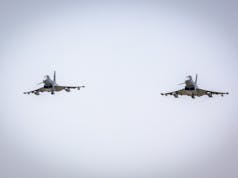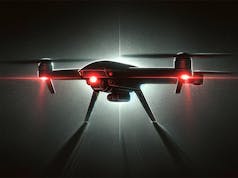Uniquely for a vessel of this type, it will be common to see the jump-jet F-35B appear to land conventionally.
This is a process called Shipborne Rolling Vertical Landing. It is a process designed to land jump-jet aircraft that uses both the vertical thrust from the jet engine and lift from the wings, thus maximising the payload an aircraft can return with and stopping the financial waste that comes with dropping expensive weaponry in the sea in order to land vertically.
Another operational advantage of this technique is that it can increase the landing payload capacity of a V/STOL aircraft, which can be restricted when it lands vertically. It can also reduce the level of wear on the lift engines and extend their operational life. Similarly, it can reduce the amount of wear upon the deck surface of a carrier caused by the downward jet exhaust from vertical landings.
SRVL landing is under development for use with the F-35B when it enters service with the Royal Navy in 2018. Rolling landings will enable the F-35B to land on these carriers with an increased weapon and fuel load and will use the aircraft’s computer controlled disc brakes.
The Queen Elizabeth class mark a change from expressing carrier power in terms of number of aircraft carried, to the number of sortie’s that can be generated from the deck. The class are not the largest class of carrier in the world but they are most likely the smallest and least expensive carrier the Royal Navy could build which still have the advantages that large carriers offer.
Now that the UK has committed to a fleet of 138 aircraft, details on the structure of the F-35 force have been revealed.
It is expected that the UK will build a front-line fleet of 48 aircraft with each squadron having 12 jets. A fifth unit, an operational conversion unit, will also operate 12 aircraft.













I’d love to know what weight, i.e. residual fuel and weapons load, was dialed into the simulation.
The large letter W on the deck would suggest that you have the wrong ship.
That’s ok, I don’t think it really matters.
The PoW will enter service with the Bedford light system invented to ease SRVL. QE will not.
“It can also reduce the level of wear on the lift engines and extend their operational life”
Ignoring the typo that implies a separate lift engine, how is this achieved? SVRL requires full vertical thrust in addition to lift supplied by the wings/body.
It’s believe it’s quite simple, SRVL is quicker than conventional VTOL, so maximum thrust isn’t being used for as long.
The need for SVRL, and the use of STOVL, on a ship this size is an embarrassment.
Fergus Mason+
There is nothing embarrassing about STORL this is exactly how both the ship and the plane were designed to operate. This is the way the Harrier operated and as the ship and the F35B’s propulsion system are also both British designed and built it is not surprising that the original successful operating concept was successful it is therefore only natural that it should be retained.
The reason that the US marines do not use rolling landings on their “Gator Navy” ships is probably because their flight decks somewhat narrower than the QE’s and thus lack the deck space for continuous rolling landings. However, when they come to their specialist task of operating the F35B’s in very close support of their Marines fighting on land using makeshift land bases the ability to be STORL should come in very useful to them.